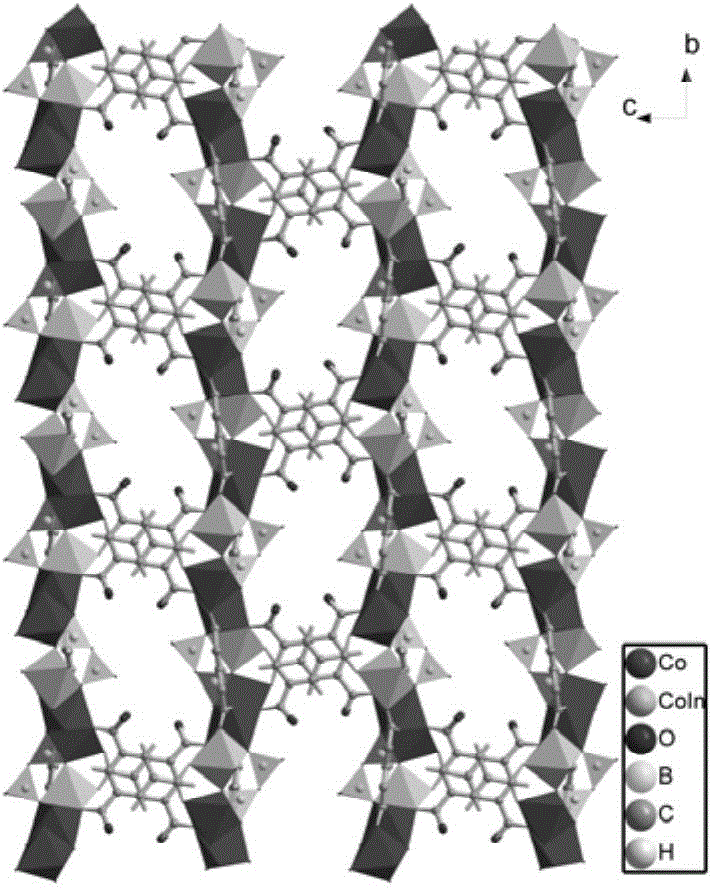Hypoboric acid benzene tricarboxylic acid cobalt-indium micro-porous crystal and preparation method thereof
A technology of pyrenetricarboxylic acid and diboronic acid, applied in chemical instruments and methods, other chemical processes, luminescent materials, etc., can solve the problem of less channel materials
- Summary
- Abstract
- Description
- Claims
- Application Information
AI Technical Summary
Problems solved by technology
Method used
Image
Examples
Embodiment 1
[0019] 0.75g (3mmol) cobalt acetate tetrahydrate, 0.26g (1mmol) indium trioxide, 0.25g (4mmol) boric acid, 0.22g (1mmol) 1,3,5-tribenzenetricarboxylic acid, 1.0g (6mmol) Add 1-ethyl-3-methyl-imidazole into the polytetrafluoroethylene liner and mix evenly, then put the polytetrafluoroethylene liner into the reaction kettle, and react at a constant temperature of 150°C for 7 days, and then at 10°C / The cooling rate of min is cooled to normal temperature, and the purple diamond-shaped microporous crystal cobalt indium diboronic acid 3-benzenetricarboxylate is obtained, and its yield is 65%, and the molecular formula is Co 5 In (BTC) 4 [(B 2 o 4 (OH)] 2 , where BTC stands for 1,3,5-tribenzenetricarboxylate, with a molecular weight of 1443.18, belonging to the monoclinic crystal system, P2 1 / c space group, cell parameter a is b for c for β is 98.208(2)°.
[0020] like figure 1 As shown, the asymmetric molecular structure of the cobalt indium diboronic acid tricarboxyla...
Embodiment 2
[0023] 0.75g (3mmol) cobalt acetate tetrahydrate, 0.12g (0.5mmol) indium trioxide, 0.13g (2mmol) boric acid, 0.13g (0.5mmol) 1,3,5-tribenzenetricarboxylic acid, 0.35g ( 2mmol) of 1-ethyl-3-methyl-imidazole was added into the polytetrafluoroethylene liner and mixed evenly, then the polytetrafluoroethylene liner was put into the reactor, and reacted at a constant temperature of 150°C for 10 days, and then 10 The temperature was lowered to room temperature at a cooling rate of °C / min to obtain purple rhombic microporous crystals of cobalt indium diboronic acid 3-phenylenetricarboxylate with a yield of 54%. The molecular formula, crystal structure parameters, pore volume, and pore diameter were the same as in Example 1.
Embodiment 3
[0025] 0.75g (3mmol) cobalt acetate tetrahydrate, 0.50g (2mmol) indium trioxide, 0.4g (6mmol) boric acid, 0.65g (3mmol) 1,3,5-tribenzenetricarboxylic acid, 1.0g (6mmol) Add 1-ethyl-3-methyl-imidazole into the polytetrafluoroethylene liner and mix evenly, then put the polytetrafluoroethylene liner into the reaction kettle, and react at a constant temperature of 170°C for 5 days, and then at 10°C / The temperature was lowered to normal temperature at a cooling rate of 1 min to obtain a purple diamond-shaped microporous crystal cobalt indium diboronic acid 3-benzenetricarboxylate with a yield of 57%. The molecular formula, crystal structure parameters, pore volume, and pore diameter were the same as those in Example 1.
PUM
 Login to View More
Login to View More Abstract
Description
Claims
Application Information
 Login to View More
Login to View More - R&D
- Intellectual Property
- Life Sciences
- Materials
- Tech Scout
- Unparalleled Data Quality
- Higher Quality Content
- 60% Fewer Hallucinations
Browse by: Latest US Patents, China's latest patents, Technical Efficacy Thesaurus, Application Domain, Technology Topic, Popular Technical Reports.
© 2025 PatSnap. All rights reserved.Legal|Privacy policy|Modern Slavery Act Transparency Statement|Sitemap|About US| Contact US: help@patsnap.com



